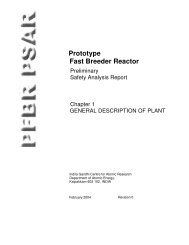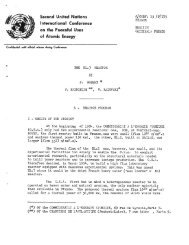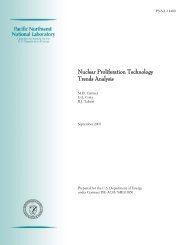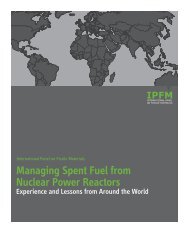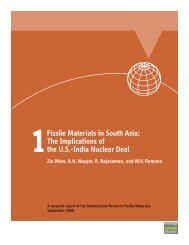Global Fissile Material Report 2009: A Path to Nuclear Disarmament
Global Fissile Material Report 2009: A Path to Nuclear Disarmament
Global Fissile Material Report 2009: A Path to Nuclear Disarmament
You also want an ePaper? Increase the reach of your titles
YUMPU automatically turns print PDFs into web optimized ePapers that Google loves.
Figure 2.3. An Advanced CruiseMissile is loaded on<strong>to</strong> the wingof a B-52 at Minot Air ForceBase (North Dakota). In August2007, six nuclear-armed AdvancedCruise Missiles were inadvertentlyloaded on<strong>to</strong> a B-52bomber and flown <strong>to</strong> BarksdaleAir Force Base (Louisiana). Thetransfer remained unaccountedfor at both bases and by thecrew until discovered 36 hourslater. Source: Jocelyn Rich, U.S.Air Force, picture available onwikipedia.org.Resistance <strong>to</strong> nuclear disarmament <strong>to</strong>day comes primarily from policy makers, formerofficials and intellectuals who have come <strong>to</strong> embrace nuclear deterrence and fromthe nuclear-weapon-complex, which relies on these weapons for its existence. Publicsentiment world-wide largely is in favor of nuclear abolition, with polls showingoverwhelming majorities even in the nuclear weapons states (except Pakistan, wheremargins are much smaller) in favor of an international verified agreement <strong>to</strong> eliminatenuclear weapons. 112 The issue is not, however, keenly felt and public opinion is notmobilized in<strong>to</strong> an anti-nuclear movement on the scale that has been able in the past<strong>to</strong> impact policy.<strong>Disarmament</strong> ChallengesThere are several challenges facing the transition <strong>to</strong> a nuclear weapon free world and <strong>to</strong>assuring its security and stability. These include the mechanism or process shaping thedisarmament trajec<strong>to</strong>ry, the issue of reversibility, the management and elimination offissile material s<strong>to</strong>cks, and the risks of nuclear weapon reconstitution or proliferationusing material and capabilities in civilian nuclear energy programs.Overall agreement or step-by-step? One of the overarching issues is whether countriescommit <strong>to</strong> the explicit goal and an agreed framework for achieving nuclear disarmament,or whether they continue with an ad hoc approach of nuclear reduction andnonproliferation steps. 113Both approaches have been and likely will continue <strong>to</strong> be used. As part of the 2000NPT Review Conference, the nuclear-weapon states party <strong>to</strong> the Treaty agreed <strong>to</strong> a programof thirteen steps <strong>to</strong>wards the goal of meeting their obligations under Article VI.These steps included meeting specific targets and set timelines. 114 There have, as yet,been no formal talks among the five nuclear weapon states that are Parties <strong>to</strong> the NPTon achieving these obligations but their year-2000 agreement has helped frame thesubsequent debate. At the same time, the United States and Russia, which account formore than 90 percent of the world’s nuclear weaponry, have engaged in a fitful stepby-stepbilateral process of arms control and reductions that has yielded significantreductions in their nuclear arsenals.The balance between an agreed plan for disarmament and a step-by-step approach willhave a bearing on declarations of s<strong>to</strong>cks of fissile material. It would be natural in anoverall plan for the nuclear-weapon states <strong>to</strong> commit <strong>to</strong> prepare and declare a complete28 <strong>Global</strong> <strong>Fissile</strong> <strong>Material</strong> <strong>Report</strong> <strong>2009</strong>



